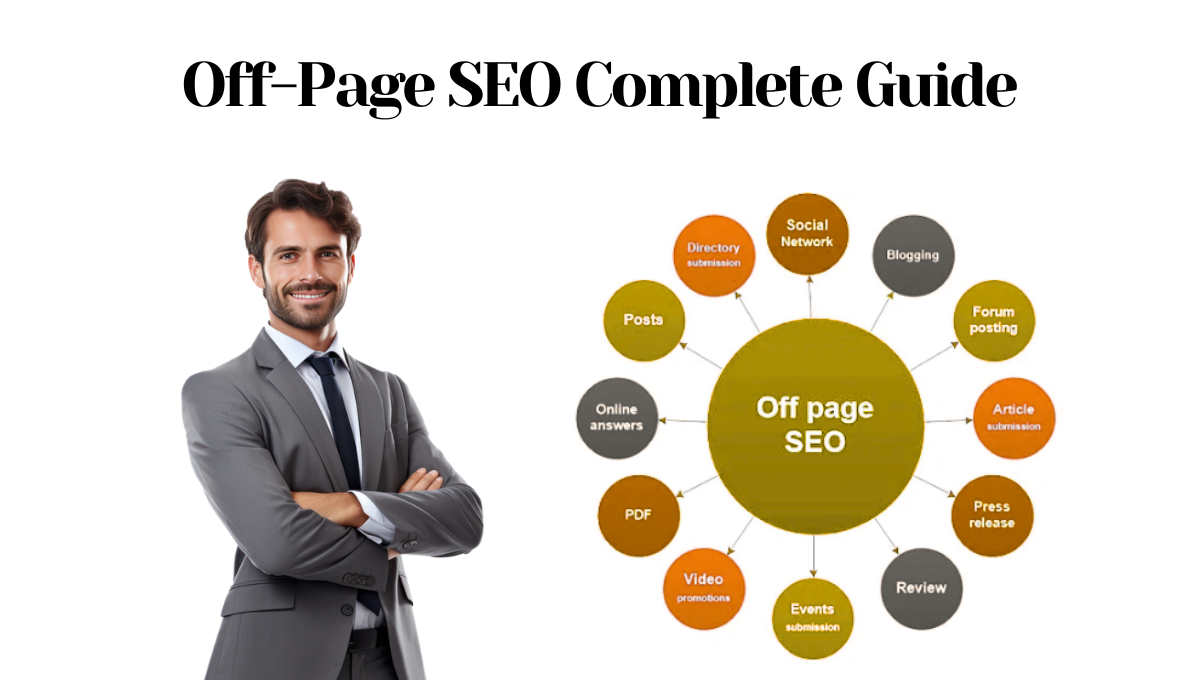In a world where attention is money, making your website a lead-generating machine isn’t just smart; it’s necessary for survival. In today’s highly competitive digital world, lead generation is essential for business growth. If you want to grow your business, the most important thing you can do is learn how to generate leads through SEO. Why? SEO does more than just improve a website’s rankings; it also brings in high-quality traffic that turns into profitable leads.
57% of marketers say that SEO gets them more leads than any other way to market. A good search engine optimization lead generation strategy can help businesses get high-quality leads and turn them into loyal customers.
What Is SEO Lead Generation and Why Does It Matter
SEO lead generation is the process of getting potential customers to your website, turning them into paying customers, and keeping them there. By improving your website and content, you can connect with people who are actively looking for the goods or services you offer and get leads who are more likely to be interested in what you have to offer. SEO leads are usually more valuable because they are already looking for answers to problems related to your business.
Why is it important? The SEO lead generation services industry has grown quickly because businesses are using search engine optimization to get more leads and make themselves more visible. SEO leads come from organic searches that show real interest, so they are more likely to turn into sales than cold leads.
10 Ways to Get More Leads through SEO:
Here are the 10 reliable methods to get more leads through SEO:
1. Identify and Understand Your Ideal Target Audience
To have a successful SEO lead generation strategy, you need to know who your ideal target audience is. The more you know about your potential clients, the better you can target your SEO efforts to get them to your site. This means understanding:
- Their Problem Points: What problems do they have that your product or service can help with?
- How They Search: What keywords do they use to find solutions that are similar to yours?
Once you have this information, make sure your website and content are optimized to attract SEO leads that will help your business. Focussing on high-intent prospects can help you get more sales and grow your business over time. This will make your business more visible in your field and give you a better return on your investment.
2. Perform Strategic Keyword Research for Lead Generation
An essential component of any SEO lead generation strategy is keyword research. You can optimize your content and generate SEO leads by knowing the keywords that your potential customers are using. Pay attention to:
- Long-tail keywords: Long-tail keywords are niche terms that have a higher conversion rate but less competition.
- Buyer Intent Keywords: Keywords that convey an instantaneous desire to buy or enquire are known as buyer intent keywords.
| Keyword | Search Volume | Competition | Buyer Intent |
| SEO Lead Generation | High | Medium | High |
| SEO Leads | Medium | Low | High |
| Get SEO Leads | Low | Low | High |
For example, instead of targeting common keywords like “SEO,” try focusing on “how to get SEO leads” or “SEO lead generation services” for more targeted traffic.
3. Create Intent-Driven Content That Converts
Content creation is the cornerstone of SEO lead generation, accounting for up to 67% of all sales opportunities. By creating intent-driven content, you can attract visitors who are already prepared to convert into valuable leads. When you align your content with the user’s intent, you increase the likelihood that visitors will become SEO leads. Here’s how:
- Respond to the Enquiries of Your Audience: Create content that answers your audience’s questions.
- Provide Solutions: Address their concerns and emphasize the advantages of your products and services.
- Employ Powerful Call-to-Actions: Incorporate calls-to-action (CTAs) that point customers to the next phase of the buying process.
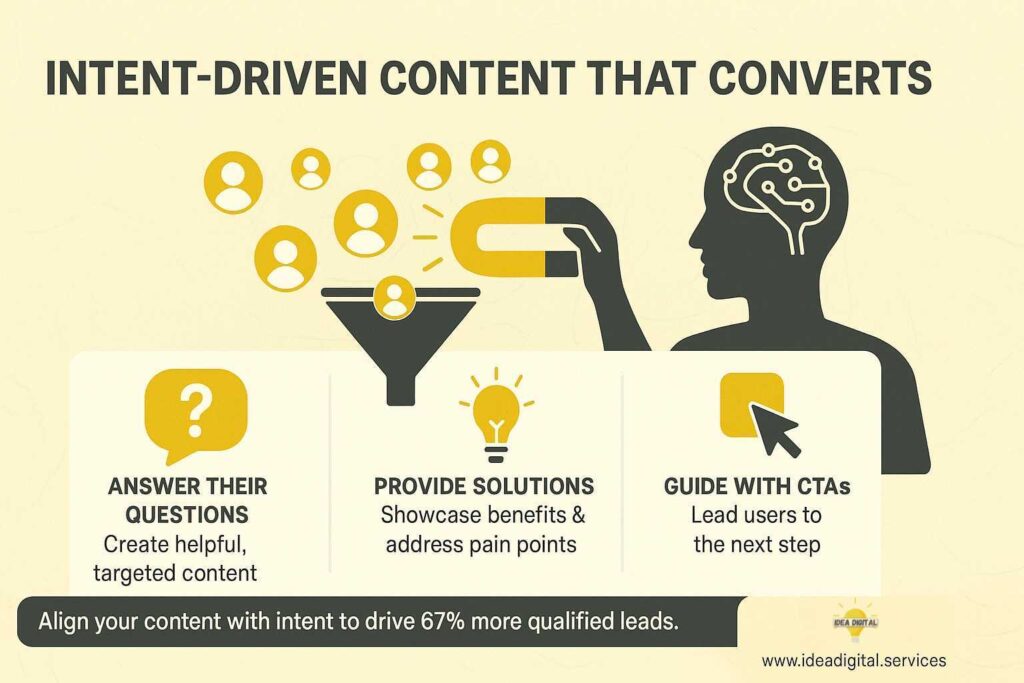
4. Optimize On-Page SEO for Better Conversions
On-page SEO is the process of optimizing individual web pages to rank higher and draw in more relevant traffic. By optimizing on-page elements, you can increase the quality of your leads and draw in more SEO leads. It includes:
- Optimizing title tags and meta descriptions: Make sure they are interesting and contain your target keywords.
- Making use of headers (H1, H2, etc.): Effective use of headers (H1, H2, etc.) enhances content readability and search engine optimization.
- Internal Links: Internal linking improves user engagement and makes navigation easier.
5. Audit Your Website’s Technical SEO
Before you start writing content or doing keyword research, you need to make sure your website is technically functional. The first step to getting SEO leads is to have a website that loads quickly, is easy to use, and works well on all devices. Conducting a technical SEO audit guarantees that search engines can locate and rank your content with ease, which facilitates the creation of SEO leads. Here are some important things to think about when auditing:
- Page speed: Websites that load slowly lose visitors and leads. A website that loads quickly will get better SEO and keep users coming back.
- Mobile optimization: A website that works well on mobile devices is very important because more than 60% of all web traffic comes from mobile devices.
- Site Structure: Search engines can find and index your pages more easily if your website is well-structured.
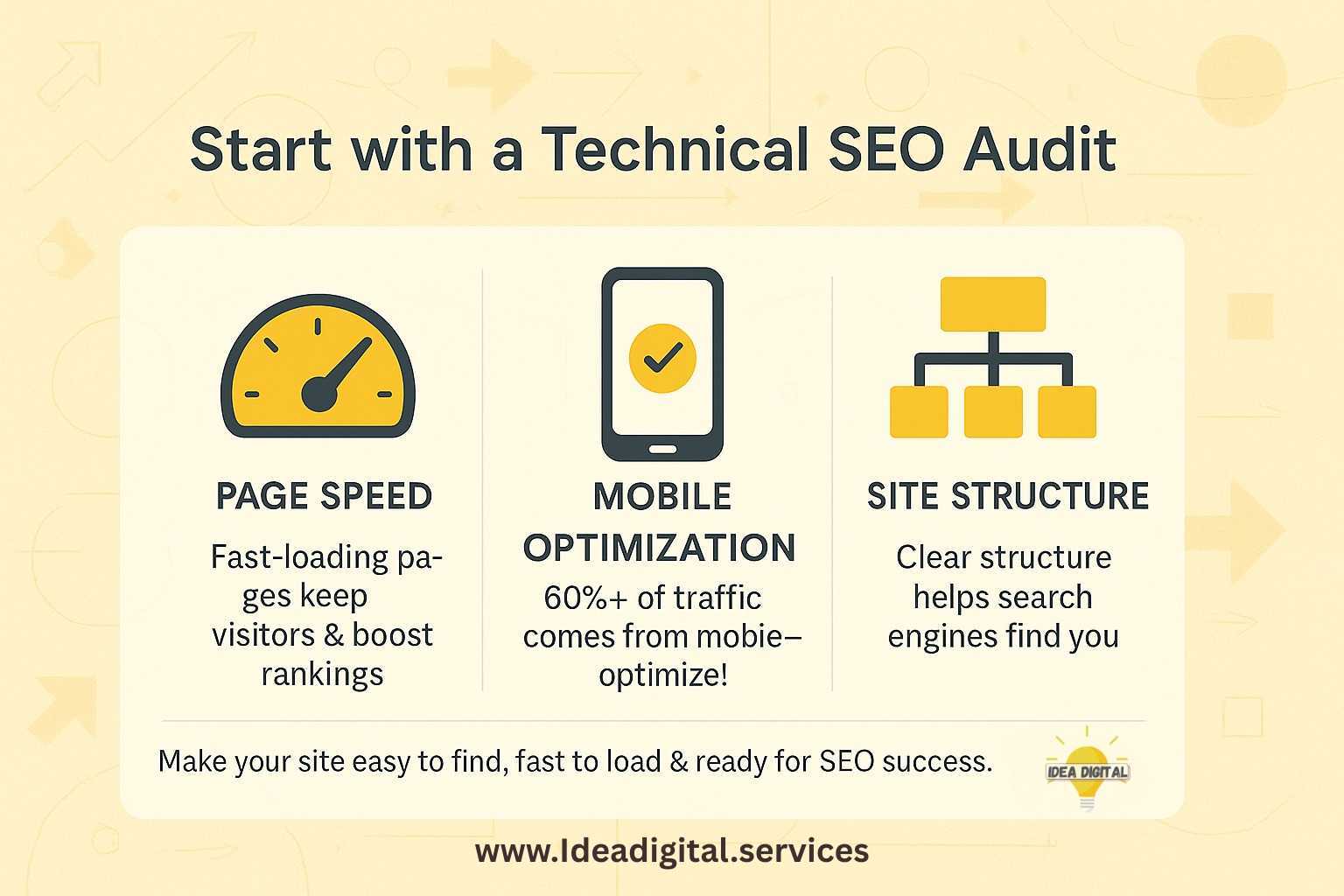
6. Build High-Quality Backlinks to Increase Authority
Did you know that websites with high-quality backlinks have a 50% higher chance of appearing on Google’s first page? Getting backlinks from trustworthy, high-quality websites is one of the best ways to increase the effectiveness of your SEO lead-generation efforts. Search engines view backlinks as an indication of dependability, which can improve your rankings. Keep an eye on:
- Guest Blogging: You can build your brand as an authority in your industry and get backlinks by contributing to reputable websites.
- Establishing Influencer Collaborations: By collaborating with influencers in your field, you can increase your reach and authority by obtaining organic backlinks from their websites or social media accounts.
- Getting Featured on Reputable Websites: Getting featured on reliable websites can boost your credibility and help you develop useful backlinks.
- Broken Link Building: Look for broken links on reputable websites and offer your content as a substitute. This method not only helps you get backlinks, but also helps the owner of the website.
- Creating Shareable Content: Over time, content that people want to link to, like research reports, infographics, or well-known blogs, can naturally acquire high-quality backlinks.
- Making Directory Submissions: Verify that your business is listed in reputable local and online directories, as these can provide additional backlinks to improve your search engine optimization.
7. Local SEO Optimization (If You’re Location-Based)
If your business serves a specific area, local SEO is an important part of your SEO lead generation plan. Local SEO can help you get customers who are looking for services in your area. Local SEO can help you find SEO leads who are not only interested but also nearby and ready to do business with you. For Local SEO Optimisation, you need to pay attention to the following:
- Listing on Google My Business: Check that your business is on Google My Business and that the information is up to date.
- Local keywords: Try using phrases like “SEO lead generation services near me” or “SEO leads in [Your City].”
- Reviews from people in the area: Getting good reviews from customers will help your reputation and your rankings in local search engines.
8. Track Results, Test, and Continuously Improve
SEO is a long-term plan that needs to be watched and improved all the time, not just once. By keeping an eye on your results, you can see how well your SEO efforts are working and where you need to improve. This is how to keep an eye on and improve your plan:
Key Metrics to Keep an Eye On:
Traffic: Keep an eye on how much natural traffic your website gets. Using tools like Google Analytics, you can find out which pages are getting the most traffic and how many visitors are coming from search engines.
Conversion Rates: Do your visitors buy something or become leads? That’s your conversion rate. Use Google Analytics conversion tracking tools to see how many people are doing things on your site, like signing up for your newsletter or downloading a guide.
Rankings of Keywords: Check on how well your targeted keywords are doing regularly. Keep an eye on your rankings for certain keywords and see if your pages are moving up in the search engine results.
Tips for Continued Improvement:
- Testing: Test different parts of your website, like headlines, calls to action, and page layouts, often to find out which ones work best. Even small changes can make a big difference in conversion rates.
- Check out how users act: You can use heatmaps from different programs to see how users interact with your pages. You can make your content and user experience better by seeing what they click on or where they stop.
- Update your content often: Search engines like content that is fresh and new. Add new information, keywords, and internal links to old blog posts, product descriptions, and other content regularly to keep your site up to date.
- Get More High-Quality Backlinks: You should always look for ways to get links from websites that are well-known. More backlinks will make your site more authoritative, which will improve its rankings and bring in more SEO leads.
- Looking at the competition: Watch what your competitors do to improve their SEO. Watch their keyword rankings, content strategies, and backlink profiles. This will help you figure out what works in your niche and what needs to be better.
- Mobile Optimisation: Because more people are using their phones to browse the web, it’s important to regularly check how your site works on mobile devices. Because Google ranks mobile-friendly websites higher, you should make sure your website is set up for a smooth mobile experience.
- Technical SEO Audits: Do regular technical SEO audits to find problems like broken links, pages that take a long time to load, or crawl errors. Use tools like Sitebulb or Screaming Frog to find and fix these problems so that performance stays at its best.
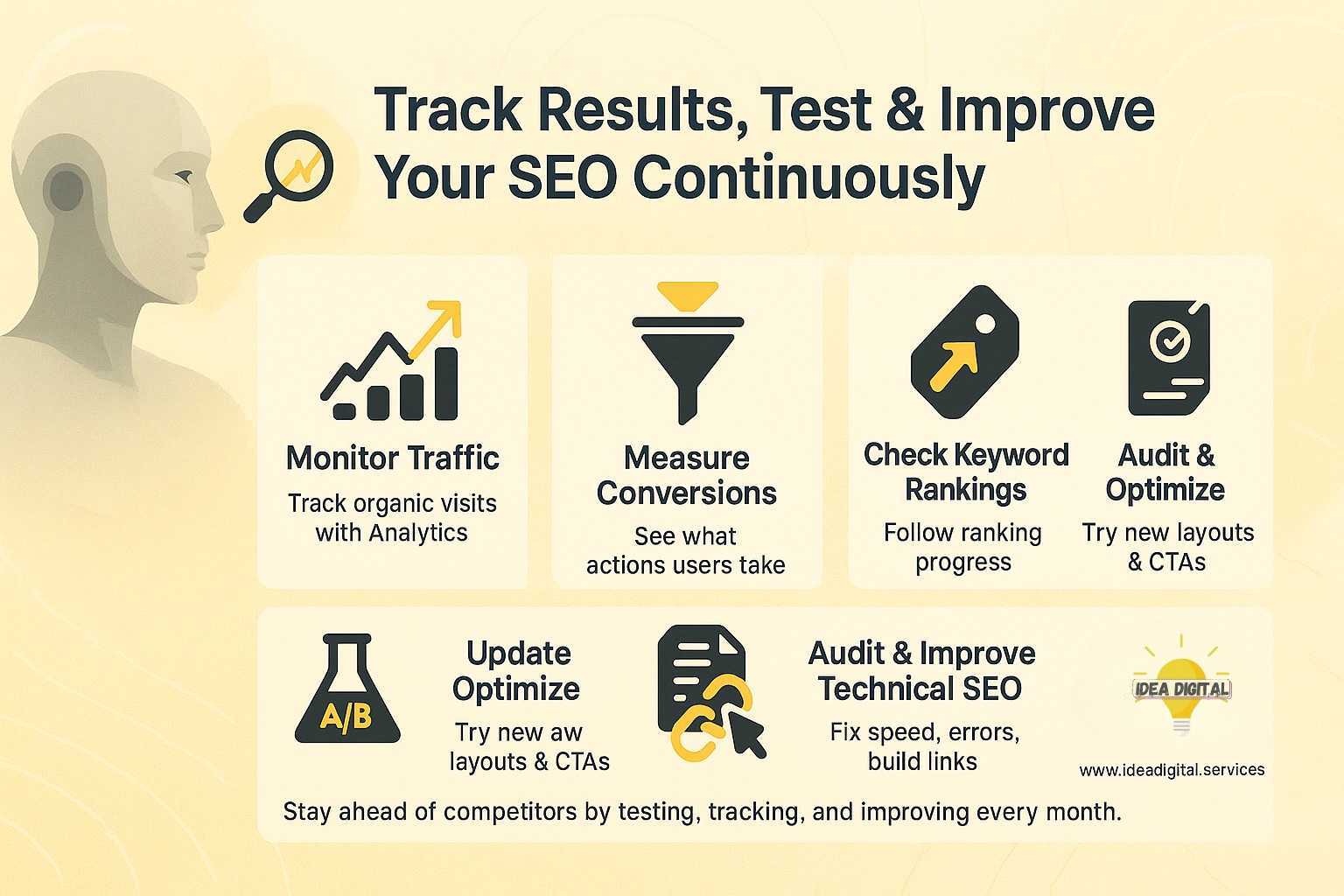
9. Know When It’s Time to Get Professional Help
While DIY SEO can take you far, there comes a point when professional help is no longer optional; it’s essential. If your rankings have plateaued, your technical issues persist, or your team is stretched too thin, hiring a specialized SEO agency or consultant can be a game-changer.
According to a 2023 SEMrush report, 68% of small businesses that outsourced SEO saw measurable improvement in keyword rankings and qualified lead generation within six months. Professionals bring expertise in advanced keyword clustering, competitive gap analysis, link acquisition, and performance tracking, strategies that may be too time-consuming or complex to manage in-house.
Whether it’s a full-scale SEO audit, local SEO strategy, or enterprise-level content revamp, bringing in external expertise can help you scale faster, avoid costly mistakes, and maintain consistent growth.
10. Integrate SEO with Conversion Rate Optimization (CRO)
Getting visitors to your site is only half the battle; converting them into leads is what drives ROI. That’s where Conversion Rate Optimization (CRO) comes in. CRO focuses on turning your organic traffic into action-takers by improving the user experience and fine-tuning key touchpoints.
According to HubSpot, businesses that combine SEO with CRO improve their lead conversion rates by up to 50%. From optimizing CTAs and page layout to using A/B testing and heatmaps, CRO works hand-in-hand with SEO to make sure your hard-earned traffic doesn’t bounce; it converts. Here’s how to start:
- Test and tweak CTA placements to find what draws the most clicks.
- Use exit-intent popups to capture leads before they leave.
- Add live chat or lead magnets on high-traffic blog pages.
- Eliminate distractions on landing pages by keeping the focus on one conversion goal.
- Use clear, action-oriented copy that guides users through the decision-making process.
By marrying SEO with CRO, you can turn a high-traffic site into a true lead generation powerhouse, one that not only ranks but sells.
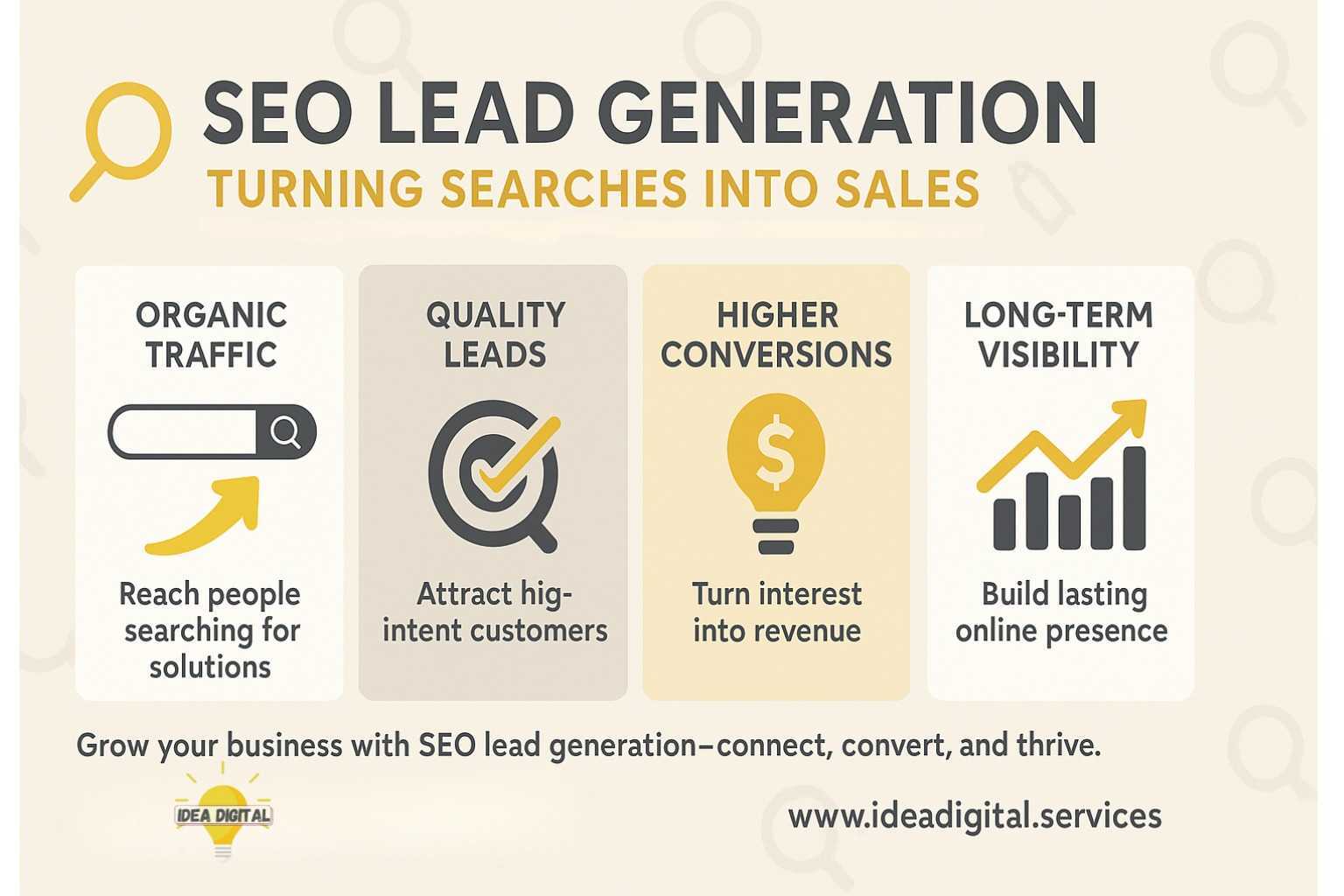
Final Thoughts: Putting Your SEO Lead Generation Strategy into Action
You can build a solid SEO lead generation foundation that will draw in quality leads and support the expansion of your company by following these nine steps. Remember that the goal of SEO is not only to rank well on Google but also to generate SEO leads that have a higher chance of becoming loyal brand advocates and paying customers.
Now is the time to take action and implement these tactics. Whether you’re doing it yourself or with an SEO lead generation service, long-term success hinges on staying consistent, tracking your progress, and refining your tactics.
For digital agency lead generation in particular, these steps ensure a steady stream of high-quality leads who are actively seeking your services. By focusing on search engine optimization and lead generation, you can improve return on investment, generate sustainable growth, and enhance lead quality. Start today to transform your website into a powerful tool for generating targeted SEO leads that help your business grow.
FAQs
Describe SEO lead generation and explain its significance.
SEO lead generation is the process of making your website better so that it will appear higher in search results and attract clients who are actively looking for your products or services. SEO leads are more likely to convert since they are already considering your products.
How long does it take for results from SEO lead generation?
It typically takes three to six months for SEO lead generation to yield measurable results, depending on the level of competition and the authority of your website. SEO is a sustained strategy that produces reliable outcomes over time.
How can my SEO lead generation approach be strengthened?
The primary methods to improve your SEO lead generation strategy are creating high-quality, intent-driven content, optimizing on-page SEO, building high-quality backlinks, and routinely assessing and modifying your strategy for better results.
How can I produce SEO leads of the highest caliber?
If you want to generate high-quality SEO leads, make sure your website is technically sound, target the right keywords, optimize your content for user intent, and build backlinks from reliable websites. You should also experiment with different strategies and regularly update your content to boost conversions.



